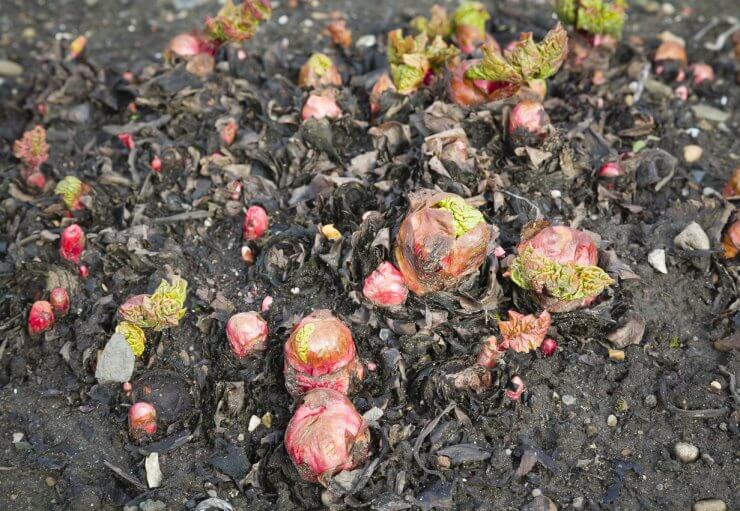
Young new shoots emerging from rhubarb crowns in soil
You can grow rhubarb from seeds, but only pursue this path if you are especially patient—and you get your seeds from a reputable source. Unfortunately, if you just snag some seeds from your gardener friend’s rhubarb plant, you don’t know what you’ll wind up with, since varietal rhubarb doesn’t grow true to seed. A healthy rhubarb plant grown from seed isn’t really ready to be harvested until its third growing season. That’s a long wait.
Your better choice is to order (or acquire from a gardening friend) rhubarb sets, also called crowns, splits, or divisions. Rhubarb grows from a rhizome from which the buds emerge. When you get a crown/split/division, it should have at least one bud on it, preferably more. Gardening centers and online nurseries may label their rhubarb starts as “roots,” but what that actually means is they’re divisions of a rhubarb plant, complete with roots, rhizome, and buds.
Seed Planting Process
Rhubarb seeds take a week or two to germinate, so plan ahead. If you live in a cooler area, you’ll want to get started early.
Indoors
Sow your rhubarb seeds indoors about two months before your expected last frost date. For best results, use a seed starting formula. Make sure your seed tray has deep individual soil compartments; 3 inches is good.
Prepare your seeds for planting by soaking them in a container of warm water for about two hours before you plan to plant them. This helps soften the papery skin of the seeds and can help with quicker germination.
Fill each individual cell with seed starting soil and plant one or two seeds per cell, about an inch deep. Lightly dampen the soil, cover the starting tray, and put it in a sunny window or under a grow light.
Once your seedlings emerge, they are going to need plenty of light. Put them by a sunny window or turn on grow lights about 4 inches above your seedlings. Leave the lights on for 16 hours, off for eight hours. Don’t leave the lights on 24/7 because most plants need a little darkness to grow.
After two to three weeks, you’ll need to transplant your seedlings to a bigger container. If you’re planning on growing them in a container rather than planting them in the ground, you might want to consider putting them in a pot 20-by-20 inches for maximum space. Plus, you’ll save yourself a series of transplants.
Ideally, you should keep your seedlings indoors for at least two months; the ideal indoor grow time is three to five months. Just make sure you don’t move them outside until the last frost is past.
Once your seedlings begin to grow, you’ll want to harden them off before you transplant them to your garden. When you’re about ready to move them outside (either in containers or to plant in the ground), give your new seedlings a little sheltered outside time, starting with an hour or two a day in indirect sunlight, progressing to a full day outside. Bring your seedlings in for the night after each outdoor foray. This process helps strengthen the plant’s cells, giving them a better chance of thriving when you transplant them.
Your garden soil temperature should be at least 40 degrees F before you set your seedlings out. When your seedlings are ready for outdoor garden time, have planting holes ready for them. Pop the seedlings out of their containers and put them right into their outdoor home. Don’t disturb the soil or root ball; the less you fuss with them, the better.
Cover the roots and attached starter soil with fresh garden soil and give them a good drink of water. If you’re concerned about pests moving in on your young plants, put a row cover over them.
Sowing directly in the garden
If you want to start your rhubarb from seed in the garden, make sure your soil is well-amended with rich compost. Rhubarb seeds can go in the ground as soon as the soil temperature has reached at least 50 degrees F. Get a soil thermometer and check your garden bed to make sure the soil’s not too cold.
Remember to soak your seeds for a couple hours in warm water to soften up the papery skin. Plant your seeds about a half inch deep, a couple inches apart, in rows 3 inches apart (chances are that not all seeds will be successful). When you get healthy seedlings, thin them out and space the seedlings 4 feet apart in rows that are 4 feet apart.
Have you tried growing rhubarb from seeds or seedlings? Which method do you prefer—and why? Please share your experiences with us.


 Previous
Previous


How many plants do you recommend for a family of one or two?
I grew from seeds by simply planting them in the soil 3 seasons ago. Next time, I’ll do it differently. Although exciting to see the seedlings homebuyers snd
FAT fingers ruined the message…see the seedlings come up and they are really cute when do small, it is a test in patience.